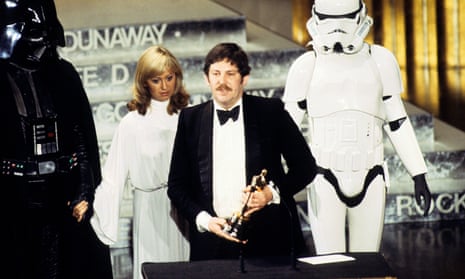John Mollo, who has died aged 86, received his first credit as costume designer on Star Wars (1977). Until then, he had served as historical adviser, with a special interest in costumes, on films including The Charge of the Light Brigade (1968), Nicholas and Alexandra (1971) and Stanley Kubrick’s Barry Lyndon (1975). On the last of these, he was responsible for the authenticity of costumes worn by around 250 soldiers from the Irish army who had been hired as extras to portray the forces of England, Prussia and France in the seven years’ war.
But it was Star Wars that transformed Mollo’s career, as was the case for most of the people who worked on it. The artist Ralph McQuarrie had come up with the original paintings for the characters; it was Mollo’s job to make them a reality. “Though I had the outline, I had to provide the detail,” he said. “In this it was no different to doing, say, an 18th-century subject where the paintings of the time would naturally be one’s inspiration.”
To bring to fruition the chilling industrialised menace of Darth Vader, he sourced materials from three separate areas of the London costumier Bermans – “the ecclesiastical department for a robe, the modern department for a motorcycle suit and the military department for a German helmet and gas mask. We cobbled it all together, and there was Darth Vader.” The director, George Lucas, had detailed ideas about the film’s costumes and colour scheme, preferring worn-looking materials and basic patterning (whites and fawns for the heroes, blacks and greys for the villains, with the exception of the Stormtroopers) so that the costumes should not draw attention to themselves. “Colour is very, very difficult to use in costumes,” Mollo noted. “Bright colours don’t work well on film, particularly reds and blues. George always goes for the authentic.”

His work on Star Wars won Mollo the first of two Academy awards; the second was for Gandhi (1982), Richard Attenborough’s best picture winner, which he shared with Bhanu Athaiya. Accepting that first Oscar, Mollo pointed out that his creations were “really not so much costumes as a bit of plumbing and general automobile engineering”. His services were retained for the first Star Wars sequel, The Empire Strikes Back (1980), though with another director, (Irvin Kershner), in charge this time, and Lucas, with whom he had collaborated closely and happily, not always available for consultation. As such, this was a less fulfilling experience. “I was very glad when it was over,” he said.
Mollo was born in London, one of three sons of an English mother, Ella (nee Cockell), and a Russian émigré father, Eugene Mollo. Both parents were artists. It was his father’s collection of military badges and toy soldiers that first ignited Mollo’s interest in the detail and differences of uniforms. After being educated at Charterhouse school in Godalming, Surrey, and at the Farnham School of Art, he was posted to Hong Kong with the King’s Shropshire Light Infantry for his national service.
He wrote or illustrated more than a dozen volumes on military costume and history that included Uniforms of the Royal Navy during the Napoleonic Wars (1965); the wide-ranging Military Fashion: A Comparative History of the Uniforms of the Great Armies from the 17th Century to the First World War (1972); Into the Valley of Death: The British Cavalry Division at Balaclava, 1854 (1991), co-authored with his brother Boris; and From Corunna to Waterloo with the Hussars, 1808 to 1815 (2013).

It was his younger brother Andrew’s work as an adviser on It Happened Here (1964), a disturbing vision of British life under Nazi occupation, that made Mollo realise that he, too, could make a better living from his enthusiasms. After Star Wars he returned only occasionally to his old role of historical adviser (on the 1978 Zulu sequel, Zulu Dawn, for instance), preferring to concentrate on costume design for science fiction, such as Alien (1979), Outland (1981) and Event Horizon (1997), or period pieces including Greystoke: The Legend of Tarzan, Lord of the Apes (1984), King David (1985) and Clint Eastwood’s White Hunter, Black Heart (1990).
Mollo worked twice more with Attenborough, on the apartheid drama Cry Freedom (1987) and the biopic Chaplin (1992). His last credits were on the television adaptations of CS Forester’s Hornblower series, starring Ioan Gruffudd as the eponymous Royal Navy officer, beginning with Horatio Hornblower: The Duel (1998) and ending with Hornblower: Duty (2003).
He is survived by his second wife, Louise Pongracz, and their son, Tom.

Comments (…)
Sign in or create your Guardian account to join the discussion